|
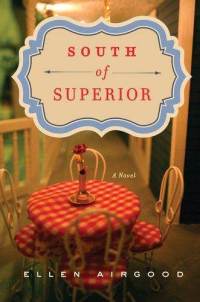
South
of Superior by Ellen Airgood
Book
review by guest reviewer Tim Bazzett
Publisher:
Riverhead Books
Hardcover,
374 pages
Price: $25.95
ISBN:
I LOVE
THIS BOOK! Can't tell you how many times I said this out loud to my self, to my wife and anyone else around, while I was reading
it. And I'm not really sure how to explain it, because it's such a quiet story; a sadly sweet, wise and wonderful look at
all the ups and downs of regular folks, many of them barely scraping by, in a small town at the top of Michigan's Upper Peninsula
(UP). And it's told in the most delightfully simple and ordinary language - none of that so-called "muscular prose" often
employed by the products of countless MFA programs around the country. Because author Ellen Airgood, who has run a diner in
Grand Marais, Michigan, for nearly twenty years, seems to have learned how to write by waitressing! Which, when you stop and
think about it, would indeed offer endless opportunities to meet and observe people of all sorts and draw some interesting
conclusions. And, since her fictional town of McAllaster is also a tourist town, just SOUTH OF SUPERIOR, i.e. on the stony
shores of Lake Superior, the mix of humanity Airgood had to observe and draw from was even further leavened.
And Airgood
is a masterful observer of people, and of all their strengths and weaknesses, faults and frailties. I think what makes this
book so pleasant to read is the way the author, and her protagonist, 35 year-old Madeline Stone, have learned to focus on
the positive things. Airgood seems to have absorbed this attitude very well and employs it to her advantage in the telling
of her heroine's tale. Madeline, who was born in McAllaster but abandoned by her teenage unwed mother at a very young age,
was raised in Chicago by a loving adoptive single mom, Emmy. After Emmy's death from cancer, Madeline feels unmoored and grief-stricken,
and decides to leave her long-time waitressing job in the windy city and return to the town where she was born, hundreds of
miles to the north. She breaks off her engagement and takes a pseudo-job in McAllaster as live-in helper with two aging sisters,
Arbutus and Gladys. The latter had been the late-in-life companion to Madeline's now-deceased grandfather, Joe Stone. Madeline
has many "issues" to work out in regard to her biological family, who had loomed large in the lives of McAllaster folks for
generations. And that is what the story is all about. I'll let you read the product description for the non-spoiler story
synopsis, okay? But here's mine: Sometimes motherhood goes beyond biology, is more than an accident of birth. Sometimes motherhood
is a conscious decision that has nothing to do with biology. This first becomes clearly evident when Madeline begins to realize
her love for a neglected wise-beyond-his-years four year-old boy, Greyson Hopkins. Grey is the son of Randi, a wild and undisciplined
teenage unwed mother in McAllaster. And Madeline becomes Grey's caretaker following a sad if predictable chain of events.
Sound familiar? Then you're starting to get why this book is so "together" - so GOOD.
"... it
fell to Madeline to entertain and watch over him. It turned out she didn't mind this at all. Taking care of Greyson helped
her keep her mind off herself. Plus she loved him."
And yes,
there is an adult love interest for Madeline too, in the person of divorced and physically damaged Paul Garceau, a transplant
from downstate who runs a pizzeria in McAllaster. But that's enough of the story. Here are some things I really loved about
SOUTH OF SUPERIOR, smaller details that I connected with on a more personal level -
1) A nine
o-clock curfew siren that blew every night in McAllaster, at which time the kids would run for home. I remember such a curfew
from my own childhood more than fifty years ago, but this story takes place in the present. The curfew makes McAllaster seem
even more caught in a time warp, but in a good and charming way.
2) The
character of old Mary Feather, living alone in a makeshift shack in the woods, selling fish and maple syrup to the locals
and tourists for a living, yet respected and loved by all the old-timers. She reminded me of "Apple Mary" an eccentric and
mysterious character from my own childhood in the fifties, who also lived alone in a shack in the country, surrounded by a
grove of old twisted apple trees. Seldom seen, she was a source of wonder to my brothers, friends and me every time we passed
her place on the way to a nearby lake to go swimming.
3) The
long abandoned and closed up Hotel Leppinen, which Madeline buys from Gladys and Arbutus and restores and reopens. Airgood
bases this on an actual old hotel in Grand Marais, but I thought of a similar one I once walked through with my mother several
years ago, then long closed, but retaining all of its ancient fixtures and furnishings. It was the Birch Lodge Resort and
Sanitarium, dating back to 1911, on Carp Lake in the UP. After a bit of online research, I've learned the Birch Lodge has
been bought and is being restored. Hooray! And shades of Madeline Stone and the Hotel Leppinen. And there is also the Osceola
Hotel, right here in my own small town of Reed City, closed up, crumbling and for sale for several years now, after a rich
and storied history of more than a hundred years.
4) An expression
Mary Feather uses about Greyson's hapless mother, Randi: "Some folks are just born to suck hind teat for life." My own grandfather
used to use that expression, "sucking hind teat" to describe the loser as he added up our scores while playing Michigan 500
rummy with my brothers and me. It always made us boys snicker and my mom frown disapprovingly.
5) This
spot-on description of the scrubland of much of the interior of Michigan's UP (and some of the Lower Peninsula too) -
"It got
worse as they headed inland. They passed the scattered cabins and camps that were too lonesome and poor to be quaint. There
were old trailers surrounded by broken-down cars and trucks, discarded toilets and cast-off woodstoves, black plastic garbage
bags stuffed with God knew what. It all sat listless in the sun, as eternal as the big lake and the pointed firs. Dogs lay
panting on short chains in bare yards, and everywhere was the barren, thin-lipped look of poverty."
This passage
brought to mind the pages-long description from the opening of WOLF: A FALSE MEMOIR, the first novel of another Michigan writer,
Jim Harrison, which I read in college forty years ago.
6) Although
Madeline has a cat, Marley, which she brings with her from Chicago, and of which the two old sisters become very fond too,
Airgood also makes a gracious and wise nod to dog lovers in this line, as old Mary Feather strokes her dog's head - "... the
truth was that a dog was a good thing to have. A dog steadied you. Just the smell of a dog, the feel of its fur, the way a
dog lived, up front and simple." Enough said. I have two dogs. Love 'em to death.
But I blather
on and on, I know. I'd better stop. Suffice it to say that this "waitress" Ellen Airgood can write like nobody's business,
and SOUTH OF SUPERIOR has taken its place on my list of favorite books. Five stars, hell! I'd give it TEN stars if I could.
I will recommend it highly and without reservation to all of my booklover friends.
Book reviewer Tim Bazzet
is the the author of the acclaimed REED CITY BOY trilogy and a new memoir, BOOKLOVER. He lives in Reed City.
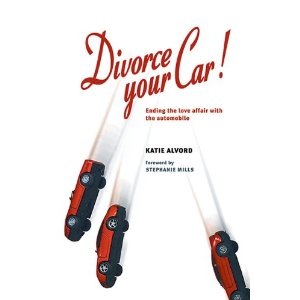
Divorce Your Care! Ending the Love Affair with the Automobile by Katie Alvord
Book Review by Zinta Aistars
·
Paperback: 320 pages
·
Publisher: New Society Publishers, 2000
·
Language: English
·
ISBN-10: 0865714088
·
ISBN-13: 978-0865714083
If you can find a copy, get this book. Published
in 2000, copies are becoming limited, yet the book has never been more relevant than today (Note to publishers: second printing,
please!). Approaching this book as someone who is very concerned about the mess we are making of our environment, yet blushingly
guilty of making a horrid daily commute in my car from one city to another, I was fascinated with the story Katie Alvord related.
That Americans are deep in a love affair with the
automobile is not news to me. Reading Alvord’s very readable and well researched background on how that auto affair
began (we tend to think of cars as coming out of Detroit, yet they were actually invented and first driven in Europe), how
it was consummated, how it is sustained and encouraged, and how it is leading us (quite purposefully by those who have something
monetary to gain) into increasingly dire straits, held my attention to the very end.
Alvord, after all, doesn’t just appropriately
horrify us with the damage done and being done. She also offers ways to extricate ourselves, divorce ourselves, if you will,
from this toxic relationship. One after another, she takes apart every argument and point of resistance. A resident of Houghton,
Michigan, in the state’s Upper Peninsula, she walks the talk and shares how that’s working out for her. It’s
inspiring. Freedom really can be delightful …
In sections entitled “Love’s Been Blind:
How We Ended Up Married to Cars,” “Grounds for Divorce: Why Our Automotive Marriage is on the Rocks,” and
“How to Divorce Your Car: Let Me Count the Ways …,” Alvord discusses the proliferation of roads and suburbs,
the role of marketing and advertising (ever notice how much of automobile marketing is about seduction and romance?), oil
spills and other damage done to our environment, the real cost of cars (eye opening),
the toll of car crashes and road rage, and finally moves into alternative lifestyles—walking, biking, public transportation,
ride sharing, telecommunications, alternative fuels (not as grand as you might think), and breaking free of auto dominance.
If you think this might make for dry reading, I
promise you it is anything but. If at first glance, I thought yikes, lot of graphs and charts! sidebars and lists! glossaries
and notes! then at second glance, I was so fascinated by the story that I found myself carrying the book along as I walked,
generally running into walls and forgetting to eat. Second glance took me through to the end, emerging with a newfound resolution
to become “car lite” if not eventually free of those tires beneath me.
“If
enough environmentally concerned North Americans responded to the finding that car driving is their most environmentally harmful
activity and decided to divorce their cars, going either car-lite or car-free, we might move a long way toward ... a shift
like this could make the world look quite different in 20 or 30 years. It could give us a world of compact, convivial communities,
with distinct boundaries, surrounded by green space, connected more often by rail. It could contribute to a more relaxed pace
of life, clean the air and water, and restore a blessed quietude that has otherwise all but disappeared behind engine noise.
We would be healthier, walking and cycling down streets in the shade of trees planted where asphalt used to be. Children and
the elderly would feel safer on the streets and have more independence without having to rely on others to drive them places.
We’d have billions of dollars worth of infrastructure that could be reallocated to other uses … we would save
money, and we would save lives.” (Pg. 241)
Freelance
writer Katie Alvord is best known as
the author of Divorce Your Car! Ending the Love Affair with the Automobile. Her
non-fiction work has appeared in numerous publications, including the Boston Globe,
E Magazine, Orion Afield, The Progressive, Utne Reader, and more. She also
writes fiction and poetry. A former librarian, she has worked with non-profit groups and served on local environmental and
bicycle advisory committees. In 1993, she was recognized as a San Francisco Bay Area Clean Air Champion for "making a difference"
by going car-free and writing about the experience. More recently, her series on climate change in the Lake Superior basin
won the 2007 Science Journalism Award for Online Reporting from the American Association for the Advancement of Science. She
has lectured frequently on environmental topics in the U.S. and Canada. Born and raised in northern California, she now lives
in the Upper Peninsula of Michigan.
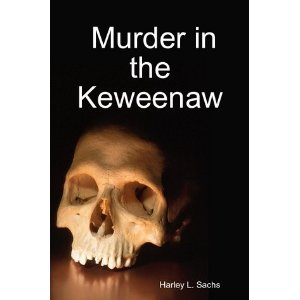
Murder in the Keweenaw by Harley L. Sachs
Book Review by Zinta Aistars
• Format: Kindle Edition
• File Size: 265 KB
• Sold by: Amazon Digital Services
• Price: $4.99
• ASIN: B003Z4K530
This Kindle reading is still pretty new to me, but when I browsed for e-books recently, I was intrigued to find
one that took place in my favorite northern haunt and one-time residence—the Keweenaw Peninsula, in Michigan’s
Upper Peninsula. For a few bucks, it was mine.
The story of Murder in Keweenaw opens with a view into the life of a semi-retired CIA agent, written as a first
person narrative, having a midlife crisis and retreating to a camp in the Keweenaw to regain his bearings. Eino, or E. J.
Carlson, fits the Keweenaw demographic well. He comes of a Finnish heritage, although was born locally, in the small town
of Lake Linden, on the Keweenaw Bay.
E. J. is recently divorced; his ex-wife Sonja has returned to her native Finland and taken their son, Jan Erik,
with her. E. J. is brooding over the loss of his family and now lives in this small camp (what U.P. residents, or Yoopers,
call cabins and cottages) in Jacobsville, spending quiet days coping with nightmares, the aftermath of PTSD (post traumatic
stress disorder) as a result of his work as an agent, and fishing. His boat is a 22-foot sloop named SISU, Finnish for courage
and an expression of Finnish pride.
While on one of his fishing trips, E. J. snags not a big fish—but a corpse. He fishes out of Lake Superior
what turns out to be the dead body of a girl with a bullet hole in her back. He calls in the Coast Guard for help, reports
to the local police, but can’t resist the pull of his own curiosity and tries to find out the girl’s identity
and the reason for her death.
What follows is some fun background description of the area. At least for me, as a former resident and now frequent
traveler in the area, I recognized most all the places and establishments named, including Lindell’s ice cream parlor
in Lake Linden, where I once was hired for my first waitressing job and, happily, was fired two days later because I couldn’t
stomach the boss’s directive to just dunk the dishes in a greasy sinkful of water rather than actually wash them. I
just couldn’t seem to do it. But I transgress …
One thing leads to another, one clue to the next, and E. J. notes what he calls a “McMansion” that
has been built near the Keweenaw Bay as an oddity. Yoopers don’t build mansions. One of the draws of the area is its
return to a simpler life, a respect for wilderness. The McMansion exudes wealth, and in the U.P., wealth sticks out like a
sore thumb. On closer inspection, and in line with a meeting on the water with the sexy inhabitant of a yacht, Roxy, E. J.
discovers a porn business flourishing inside. Pretending to be a local offering his help, which in fact he is, E. J. ends
up with an invitation to a party, where he observes porn videos being shot, and two Moldavian girls looking lost and afraid—they
turn out to be a part of the sex slave trade now so epidemic in the United States.
“If these two women were illegal imports for the sex trade, no wonder they were nervous … I know
now that the international sex trade traffics in thousands of women, twenty thousand to the United States alone, and even
more to countries like Turkey and Saudi Arabia. Girls looking for work respond to newspaper ads for waitresses and housekeepers,
jobs in foreign countries that turn out to be brothels. The destitute are exploited in this gruesome slavery and in countries
like Indonesia desperate families even sell their children to brothels that cater to pedophiles.”
E. J. pretends interest in the goings-on of the mansion on the bay in order to solve the mystery of the dead
girl. When the rich men who run the operation offer him a free taste of more than just what’s on the barbeque grill,
asking him if he is familiar with Hugh Hefner parties, he responds:
“'I saw it once on television,’ I said. I didn’t add that it was a lot
of old men in their sixties and seventies surrounded by pneumatic groupies young enough to be their daughters or even granddaughters.
The television broadcast was ostensibly a biography of Hugh Hefner, but the absence of women his own age made the scene ludicrous.
It was the fantasy of adolescents who never grow up and think they are god’s gift to women. Did the men think they were
attractive to those girls? The girls were all playmates or wannabes who would do anything to be the next magazine centerfold.
Did they have any talent, I wondered? Or were they simply exposing themselves for profit? … the girls with their t*ts
on page three had eyes reminding me of sheep. Dumb.”
And then, E. J., while solving the mystery, accepts the favors of Roxy with her implants. Perhaps more than one
sheep in this pasture.
So the author and his character delve into the dark recesses of a dark industry—of girls and women coerced
into work that can kill their spirit, their self-esteem, and perhaps even take their lives. The topic is timely and deserving
of coverage. The book is reasonably well written and reads quickly, if with the occasional annoyance of the name “Erik”
being inserted into “AmErika” and wherever else it might fit. I don’t know what the author’s idea
is by doing that—a secret nod to someone named Erik?—but for my editor’s eye, it was each and every time
a jarring distraction from the storyline.
The author, Harley Sachs, is a former resident of Houghton, at the base of the Keweenaw. He is the author of many books, most of which are mysteries,
and most if not all of which appear to be self-published. He is also the creator of a board game named Police State.
Author's explanation: the problem with Amerik happened when I
sometimes spelled it eric and sometimes Erik and used a global find and replace, which interfered with "America." Thanks for
noting that. I'll fix it.
The book is dedicated to the memory of Glen, a local from Gay,
Michigan, who was a CIA agent in Finland, married a Finnish aristocrat who divorced him and took their two boys to Finland.
Glen later committed suicide. We shared a common experience as ex-agents. It's an odd brotherhood.
~Harley L. Sachs
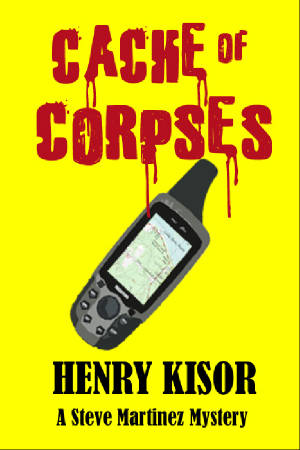
Cache of Corpses, A Steve Martinez Mystery by Henry Kisor
Book
Review by Zinta Aistars
·
Format: Kindle
Edition
·
File Size: 1054
KB
·
Price: $2.99 (book format also available)
·
Sold by: Amazon
Digital Services
·
Language: English
·
ASIN: B005NRXSKE
When I recently remarked to a writer-friend who
writes a mystery series based in Michigan’s Upper Peninsula, “But you’re the only one who writes about the
U.P., right?,” he gave me a long, meaningful gaze. You know, the kind of gaze that makes you realize you’ve just
said something really stoopid. So I did some online researching. Yeah. I did say
something stoopid.
I got a list of U.P. authors, a very long list,
I might add, and among them was Henry Kisor. My writer-friend had recommended Kisor, so I browsed through some electronic
versions of his books, and chose this one, Cache of Corpses. It is one of a series
about a detective named Steve Martinez, a Lakota Sioux by birth, now living in the very small town called Porcupine City,
in the area near the Porcupine Mountains of the U.P.
The story opens like this:
“It’s
in the Dying Room,” Jenny Benson said, voice strained, ample chest heaving. “And it has no head.”
Oh boy, I thought, coming in with a slam, and didn’t
wait a moment to add that stereotypical detective mystery bit with a heaving ample chest. Suppressing an eye roll (hard to
read that way), I settled in for the read to see where it would take me.
After a bit of a clumsy start, I became genuinely
interested in the story. Not my genre, even as I am a fan of most all things U.P., and it didn’t have the delicious
tang of humor I’d found in the Woods Cop series by Joe Heywood, but I appreciated the cast of northern wilderness characters
and the mix of woods politics—detective Martinez is running for deputy sheriff at the time that a string of murders
takes place, leaving a cache of headless, handless corpses wrapped in plastic and hidden as if on scavenger hunt for a group
of weird, sociopathic geocaching game-players.
Kisor does a good job of painting his characters
in bright and memorable colors. The detective himself is a likeable person, as is his three-year woman friend Ginny, a tough
but warm-hearted woman living in a log cabin and keeping her wealth quiet—northern folk don’t necessarily respect
monetary wealth.
Townspeople each enrich the portrait of the northern
town and its history, as does the incumbent sheriff running against Martinez in the campaign. Perhaps Tommy, the young boy
with a tragic childhood that Ginny wishes to adopt, comes off a bit flat and unbelievable, a little too perfect for a child
emerging from a mess of alcoholic and now dead parents and a tangled foster system. But the mystery itself unfolds with increasing
interest, winding through odd Internet chat rooms and big city brutes that think the tucked away northern wilderness is just
the place to hide corpses. It’s a fun if stomach-churning tale, and I’d pick up another book by this author to
see how he solves the next one.
Henry Kisor is a retired Chicago Sun Times book editor and an author of several fiction and nonfiction books, spending his winters in Chicago
and his summers in Ontonagon County, where the Porcupine Mountains are located.
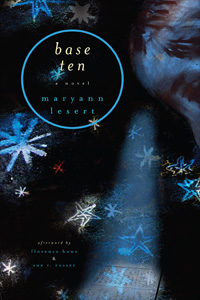
Base
Ten by Maryann Lesert
Book
Review by Zinta Aistars
·
Paperback: 304 pages
·
Publisher: The Feminist Press at CUNY, 2009
·
Price: $15.95
·
ISBN-10: 1558615814
·
ISBN-13: 978-1558615816
According to publishing industry research, women make up the majority of readers.
I’m not going to argue the popularity of romance for female readers, as I have worked in libraries before and seen the
bags of romance novels some women carry out of the library with weekly return trips for more. But there are a great many of
us who, like me, wince and roll our eyes at the mere sight of that genre. We want something else, something more, something
beyond, something deeper, something richer, and yes, something far more honest and real.
When author and playwright Maryann Lesert wrote her debut novel and sought a publisher,
she was surprised and dismayed at the response. Publishers were not turning her away for lack of literary quality of her manuscript.
Indeed, she received praise for her writing ability. They were turning her work away because, they claimed, women don’t want to read such stuff. After all, Lesert’s main character, Jillian Greer, is an astrophysicist.
If there is a romance in this story—and there is—it is not the bodice-ripping lust of Harlequin, but rather the
hunger for a relationship that allows both partners to achieve their dreams. This includes love, sure, and children, yes,
but also achievement in one’s intellectual pursuits. For Jillian, that means hard science.
Jillian has been married for ten years to Jack. They have two bright and endearing
children. Jack has a great career, and Jillian works, too, if at a held-back level that many women find themselves choosing
in order to have time and energy left over to raise a family as well. Jack is not painted as a glaring chauvinist or some
kind of bad guy. That’s too easy, and Lesert’s writing is far more subtle and nuanced than that. This is a man
who is obviously attracted to his wife for all the right reasons of true intimacy, inside and out, the whole person. He is
supportive, or at least, he tries to be. Yet Jillian finds that we live in a society that encourages one gender over the other
in a myriad of ways that still end up, at the end of the day, requiring the sacrifice of self—and usually it is the
woman making that sacrifice.
One of my favorite scenes in the book shows Jillian moving through her house at the
beginning of the day, husband and children scooted off to work and school, and seeing for the umpteenth time open drawers
with clothes spilling out in the bedrooms. If asked, husband and children will bring about order in their rooms. If asked,
all will do their part. But here’s what gets Jillian’s goat: it is always, but always, on her shoulders to do
the asking. Bottom line, it remains her responsibility to manage the household. And that makes her feel crazy. Silent, suppressed-scream
crazy. Exactly the way that so, so many women have felt in so, so many households across the world for eons.
After ten years of marriage, at age 40, realizing that she is fast approaching the
cut-off age to take part in a space program that has been her dream since completing her degree in astrophysics at Michigan
Tech University in the Upper Peninsula of Michigan, Jillian takes ten days to go off into the wild and contemplate in solitude
her predicament. She camps in Sleeping Bear Dunes in Michigan, pondering the stars in the sky that she loves so much, and
how to bring balance into her life. She loves her family very much, and she struggles with guilt at leaving them even for
this short period of time—but she feels like she is dying a slow death inside.
Gazing at the starry sky, Jillian notes:
“In the beginning, the fracturing
of light looks like life: bold, brilliant, unhampered. In the end, colors smolder with sadness, retreat. But in truth, the
progression from bold to brilliant to pale is more about fracturing and reuniting. Colors separated yearn for wholeness. Colors
of light, gases in the atmosphere, shards of yourself, yearn for wholeness.” (Page 37)
Base Ten is a story about an intelligent and accomplished woman scientist struggling with
her unresolved dreams, her human longing for love, companionship and family, alongside her equally human longing to fulfill
the hunger of a bright mind to expand its reach and fulfill its potential. It is a complex and wonderfully honest story about
a struggle women face in finding life balance every day. Is it really possible to have it all? Or does trying to have it all
merely make us into exhausted jugglers, desperately trying not to drop something of great importance.
I’m grateful to the Feminist Press of CUNY for recognizing that there is indeed
a market for a book about women and science, and that very many women readers can relate to the struggles of Jillian Greer,
as written so honestly and beautifully by Maryann Lesert. Although Jillian’s choice of career is astrophysics, Lesert
manages to make her research understandable to any reader, showing a woman’s unique approach to scientific thinking
and discovery, and interspersing short chapters of very nearly poetic scientific explanation of astronomy.
We need more books like this—for women and for men.
Lesert earned a BA in Art and English from Western Michigan University and an MFA in Writing from
Spalding University. She has worked as a graphic designer; medical writer, editor, and video producer; educational technology
coordinator; and creator of a playwriting program funded by the Michigan Council for the Arts. Currently, Lesert teaches writing
at Grand Rapids Community College.
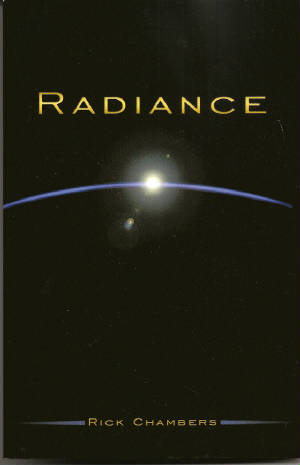
Radiance by Rick Chambers
Book Review by Zinta Aistars
·
Paperback: 264 pages
·
Price:
$16.95
·
ISBN-10: 1450253105
·
ISBN-13: 978-1450253109
Oh,
admit it. Spot the imprint of a well-known self-publishing outfit on a book, and immediately you think: this is going to be
sub-standard. Copy in need of editing, writing that no traditional publisher would touch with a ten-foot typesetting machine.
But
it’s a new day, isn’t it? Certainly that was my personal bias. Yet today, self-publishing is on the up and up.
More and more quality authors are choosing this option to see their way to the bookshelf quicker than a matter of years, keeping
tighter control on royalties, doing the promotional and marketing work themselves. There’s still a lot of bad writing
out there … but among the chaff, there are also books that are golden.
When
I picked up Rick Chambers’ book after hearing him at an author’s reading, I was pretty sure it would rise above
the level of chaff. After all, full disclosure, I’d published his work in a past issue of the literary magazine I manage,
The Smoking Poet. When the magazine celebrated its fifth anniversary of publication, Chambers was our first author
up at the podium. I’d crossed paths with Chambers at several community literary awards events, and it was him walking
to the front to receive first prize and more than once. We live in the same city, and around here, his reputation preceded
him: Chambers can write.
And
still, an old bias dies a slow death, and when I opened the slick covers of Radiance, and started to read … I
was taken aback. Hey. This is good. The copy is clean, hardly an error in it (okay, I spotted one or two, but I spot them
in bestsellers, too), nice. More to the point: the storyline, the telling and the writing of it, were very good. A few pages
in, I was lost in the story, and all thoughts of copy and publisher were faded to mist.
Radiance is a mix of science fiction and faith genres. Think C.S. Lewis with some hard metal of futuristic technology
tossed in. Indeed, perhaps this is why Chambers decided to publish the book himself. This kind of premise might be hard to
sell to a mass market, and I imagine traditional publishers may have resisted. If so, their loss. I am not a fan of either
genre (although I do enjoy C.S. Lewis), but a good story is a good story.
The
premise of Radiance is that two mysterious strangers are traveling the galaxy of the future (conclusion of the 21st
century), seeking 10 people who have “Radiance.” Not an easy task, if not impossible, for humanity by that time
has deteriorated to most shallow levels, fueled by greed. The few and the powerful, ruthless in their pursuit of material
wealth and control—namely, one Eris Lateinos—are about to take control of both humans and cyborgs. Lateinos rules
with a cruel hand. He promises happiness and riches to all, but his promises are false and laced with trickery. He enforces
his law with an army of cyborgs, part human, part machine.
Tristan
West is seemingly a nobody, once a Lateinos PR man, but now he manages to stand in Lateinos’ way at every turn. He has
a way of speaking the truth, even when it earns him a pummeling from a cyborg. The two mysterious strangers have connected
with him as being one of those who has Radiance, which takes him by surprise. Certainly, he hadn’t seen himself as a
Christian in a long time …
What
unfolds is a fast-paced intergalactic adventure, a thriller, yes, but also a story of enduring faith when there no longer
seems any reason to believe. This is not a story that preaches, but that touches lightly on faith-based ideas that survive
time and fashion. Intriguing is the question of whether Christianity might have touched on other planets and not just on Earth.
How might it be known among other life forms?
Chambers
may touch on a bit of cliché now and then, and scenes of alien meeting hooker can be amusing if predictable, but he will surprise
the open-minded reader with a fresh take on some very old questions, and manage to entertain while he does so.
Rick
Chambers is a communications professional and a former journalist. In addition to Radiance,
he is the author of three novelettes, numerous short stories, and a writer for Chronicles, a direct-to-video/online
series. He lives in Portage, Michigan.
|

